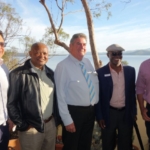Saki Macozoma: who is the man who walked beside South Africa’s great Mandela?
The former political leader and business man spent three years along side Nelson Mandela and argued over speeches as his press representative.
“Friends, comrades and fellow South Africans. I greet you all in the name of peace, democracy and freedom for all. I stand here before you not as a prophet but as a humble servant of you, the people.”
To hear these words we would have to go back in time and land in the hot afternoon of February 11, 1990 in the main public square in Cape Town, South Africa, standing elbow to elbow with thousands of people eager to see the man who would become the first black South African president.
After moving the crowds with a heartfelt greeting, these were some of the first words of Nelson Mandela’s speech following 27 years behind bars. These were words carefully thought by him and some of his political allies, including Saki Macozoma, who became his media representative in the early 1990s.
Macozoma, now 58, former student activist against the apartheid regime and ex-member of the South African parliament, visited Hong Kong this month as president of the association, Business Leadership South Africa.
Speaking to the Sunday Morning Post during his visit, he recalled the days he spent in prison with Mandela, the moments when Mandela faced the world after almost three decades in jail and their very final encounter .
“We were allowed to see him on the day before he got released, and we discussed the speech that he was going to issue after leaving the prison,” Macozoma recalled.
The conversation was long and took half the night. Macozoma then went home and put together the final draft of the speech that would echo in the following afternoon in the main square in Cape Town , which was filled with more people than it could actually carry.
“One of the things that I remember arguing about was that he wanted the speech to say Mr (FW) de Klerk, the president, was a man of integrity and we were saying that was not right,” said Macozoma.
But Mandela was able to persuade him and his fellow political activists. “He said: look, if you are going to negotiate with somebody, you have … to accept that he is a man of integrity until he proves you wrong.”
Mandela’s view left little space for argument, and he did call president de Klerk “a man of integrity”.
Racial segregation policies which were enforced under a legal system that became known as apartheid (literally meaning “separateness”) were put in place in South Africa in 1948. Black Africans – the majority of the population – and whites had to live in different areas and could not get married . Non-white participation in the national government was not allowed.
Resistance to apartheid grew stronger over the years, consisting of peaceful demonstrations, strikes and protests, some of them led by students. But as non-violence brought little progress, armed resistance groups emerged.
Mandela, a founder of Umkhonto we Sizwe (Spear of the Nation), the military wing of the anti-apartheid African National Congress, was one of many resistance leaders being thrown behind bars, where he remained from 1964 to 1990.
In the face of world pressure, de Klerk – who had started releasing political prisoners – began to scrap most of the legislation that provided the basis for apartheid in 1991.
Mandela’s first speech, a year earlier, would become a symbol of the hope for the country. “We had a lot of debate about the speech…What the political implications were, what we were trying to achieve and the kind of image that we wanted to create for him,” recalled Macozoma, who was in charge of handling the world’s media who flocked to South Africa to report on Mandela’s release.
As the time when Mandela could walk free was looming, the impatience of an unruly crowd was also increasing in the streets of Cape Town. “None of us, in the National Reception Committee or in the African government had anticipated the impact of the day… It was much bigger than we had resources for,” he described.
“the crowds were just overwhelming,” Macozoma recalled. “We couldn’t trust the police, we had minimal security… On reflection, we could have had him killed on that day, not because of a sniper or something, just by the crowds,” he said.
His mind still bears images of farmers and owners of farms lining up along rural roads that Mandela crossed in his first day of freedom. “ I can’t compare this day,” he insisted.
After facing the cheers of some 40,000 people in one day, Mandela faced the international media in the following day in a press conference . “I think all the people, including us – because we were nervous – were asking: ‘how is he going to react to this new world?’” Macozoma recalled. “It was surprising to see how adapted he was at handling media, taking questions, presenting himself.”
But Mandela was much more than a clever man able to handle journalists’ questions. His humility, honesty and presence made him to stand out, his advisor described. “Mandela was a very tall man… . And his presence was warm and accommodating rather than intimidating. ‘Kinda saying: ‘talk to me, I am a friend’.”
In the following three years, they travelled together in Africa and all over the world. Mandela would remember places and people he had met decades earlier, and even food he had tasted before going into jail. “He had an amazing memory,” Macozoma said.
Mandela and Macozoma stopped briefly working together in 1993, when the former student activist decided to go into the private sector. But the ties they forged on Robben Island prison remained intact.
They had met in 1977 when Macozoma, an organiser for the anti-apartheid South African Students Movement, started to serve a five-year sentence. He was 19 at the time. “My first vivid memory is meeting Nelson Mandela in a cell on Robben Island and he explained to me that he had been put in that cell in 1964, which was the year I started school. Just how long he had been there was very striking,” he recalled.
Macozoma described his time on Robben Island as his “real university years”. “I had the opportunity to read as much as possible, to debate as much as possible, to meet some of the most remarkable human beings that have lived in the 20th century… it was a great privilege,” he said.
“I cannot say that being in prison when you are a teenager is a good idea, but I don’t regret one hour of that,” Macozoma noted.
After leaving jail in 1982, he studied political science, economics and journalism in South Africa and in the United States, and then he joined the South African Council of Churches, the only anti-apartheid body which was not banned at the time. Following his experience as Mandela’s media person and a short stint in the private sector, Macozoma became a member of the parliament between 1994 and 1996.
He and Mandela, who became South Africa’s president in 1994, continued to work together in the National Executive of the African National Congress until Mandela retired as the nation’s leader in 1999.
At Mandela’s request, Macozoma ran a state transport company called Transnet Limited for five years, and he meanwhile returned to the private sector.
The last time Mandela and Macozoma spoke was a couple of years before he passed away. “He called me and asked me to go and see him in his bedroom, and said in jest: ‘I am not going to get up for my son when I don’t feel like it…’”
Mandela was concerned about what was going to happen to his staff after he was gone. “He wanted to make sure that he had made arrangements for them to be looked after,” Macozoma said.
Mandela died on December 05, 2013. But his voice from that same boiling afternoon, on February 11, 1990, still echoes today in many people’s minds: “Amandla! (Power!)” — he shouted. “Awethu! (Is ours!)” – the crowds responded.

